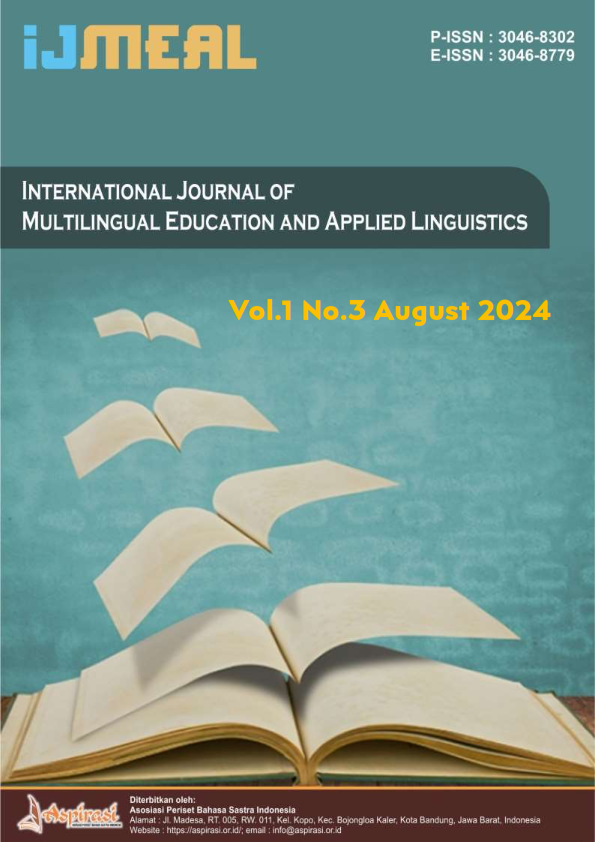The Implementation of Course Review Hooray to Teach Vocabulary at Elementary School in Mojokerto
DOI:
https://doi.org/10.61132/ijmeal.v1i3.78Keywords:
course review hooray, teaching vocabulary, Mojokerto RegencyAbstract
This research aims to describe the implementation of the Course Review Hooray (CRH) method in teaching vocabulary and to see students' perceptions of the use Course Review Hooray (CRH) in their class. This research was based on the problem of students lack of vocabulary and motivation in learning vocabulary. The design of this research is qualitative approach. The Participants in this research were 28 students from the fourth grade of elementary school in Jrambe, Dlanggu, Mojokerto Regency. The data was collected through observation and questionnaires. The result of the first research question is the implementation of Course Review Hooray (CRH) in the classroom. There are fourth steps for the implementatition. The first, students are instructed to form groups with a total of 5 students in each group. Second, each group is given a card that is used to collect points. Third, when the teacher throws questions related to transportation material and if anyone can answer the question, the students raise their hands,and then they answer the question. Fourth, if the group's answer is correct, then 1 group cheered together “Hooraay” and followed by teacher giving points to the group's card in the form of a stamp. The group that gets the most points will get a reward at the end of the lesson. Based on the results of student perception from the implementation of Course Review Hooray (CRH), most of students feel this method is exciting, fun, the class atmosphere becomes lively, and they understand the material better if they use Course Review Hooray because it is challenging as they should collect points and they are actively involved in the learning process.
References
I Gusti Ayu Winda Yuliantari, Ni Nyoman Padmadewi & I Gede Budasi, “The Implementation of Learning Vocabulary Using Flashcard for Young Children Through Google Classroom ” Jurnal Pendidikan Bahasa Inggris Undiksha, Volume 9, Number 3, 2021.
Beck, I. L., McKeown, M. G., & Kucan, L. (2002). Bringing Words to Life: Robust Vocabulary Instruction. The Guilford Press.
Strasburger, V. C., Jordan, A. B., & Donnerstein, E. (2010). Health effects of media on children and adolescents. Pediatrics, 125(4), 756-767.
Schlechty, P. C. (2011). Engaging Students: The Next Level of Working on the Work. Jossey-Bass.
Shoimin, Aris, “Model pembelajaran inovatifdalam kurikulum 2013” AR-RUZ MEDIA, Volume 68, 2016.
Astuti, Puji, “The Effectiveness of Course Review Horay in Improving Students’ Simple Past Tense Mastery”. Undegraduate Thesis S1 UNNES, 2011.
Sinta Purwatiningsih, “Improving Students’ Reading Comprehension Through Course Review Horay Method”. E-repositoryUniversitas Islam Negeri Salatiga, 2016.
Fandi Ahmad, “The effectiveness of the direct method on students' ability to master vocabulary”. Undergraduate thesis S1 Universi tas Islam Negeri (UIN) Syarif Hidayatullah Jakarta, 2014.
Aswal Syarifudin, Rismaya Marbun, Dewi Novita “An Analysis On The Students' Vocabulary Mastery A Descriptive Study On The Mts “.
Fadila Lamante “Improving Students' Vocabulary Mastery by using Story Telling in Class XI Language Students at MAN Model 1Manado”, Digital Repository IAIN Manado, 2019.
Richards, Jack C. “Curriculum Development in Language Teaching” New York: Cambridge University Press. 2002.
Jackson, Howard. ”Grammar and Vocabulary”, London: Rouletdg 2002.
Webb, S.. The effect of pre-learning vocabulary on reading comprehension and writing. The Canadian Modern Language Review. 2009.
Thornbury, Scott. How to Teach Vocabulary. Middlesex: Longman, Pearson Education. 2002.
Chaer, Abdul. Pengantar Semantik Bahasa Indonesia. Jakarta: Rineka Cipta, 2009.
Nation, I.S.P.. Learning vocabulary in another language. Cambridge: Cambridge University Press. 2001.
Kurniasih, Imas and Sani, Berlin. ”Model Pembelajaran:Untuk peningkatan Profesionalitas Guru. Yogyakarta: Kata Pena. 2015.
Riadi Muchlisin, “Model Pembelajaran Course Revew Hooray”, Kajian Pustaka. 2020.
Hermawan, Kamsiyati, Atmojo ”Efektivitas Model Pembelajaran ATI Dan CRH Menggunakan Strategi Guided Teaching Terhadap Kemampuan Pemahaman Konsep” Imajiner Jurnal Matematika dan Pendidikan Matematika.2021.
Hermawan, Kamsiyati, Atmojo ”Efektivitas Model Pembelajaran ATI Dan CRH Menggunakan Strategi Guided Teaching Terhadap Kemampuan Pemahaman Konsep” Imajiner Jurnal Matematika dan Pendidikan Matematika.2021.
Suprijono, Agus. “Cooperative Learning Teori & Aplikasi Paikem” Yogyakarta: Pustaka Pelajar.
Shoimin, Aris, “Model pembelajaran inovatifdalam kurikulum 2013” AR-RUZ MEDIA, Volume 68, 2016.
Riadi Muchlisin, “Model Pembelajaran Course Revew Hooray”, Kajian Pustaka. 2020.
Cameron, L. “Teaching language to young learners”. UK: Cambridge University Press 2001.
Nation, I.S.P.. Learning vocabulary in another language. Cambridge: Cambridge University Press. 2001.
Nation, I.S.P. Learning vocabulary in another language. Cambridge: Cambridge University Press. 2001.
J Siti Khasinah, ” Classroom Action Research” Jurnal Pionir, 2013.
Arikunto, Suharsimi dkk. “Prosedur Penelitian” . Jakarta Bumi Aksara. 2009.
Suprijono, Agus.. ”Cooperative Learning Teori & Aplikasi Paikem” Yogyakarta: Pustaka Pelajar. 2009.
Miles, Huberman, ”The Coding Manual for Qualitative Researchers” a method sourcebook. 2014.
Downloads
Published
How to Cite
Issue
Section
License
Copyright (c) 2024 International Journal of Multilingual Education and Applied Linguistics

This work is licensed under a Creative Commons Attribution-ShareAlike 4.0 International License.





